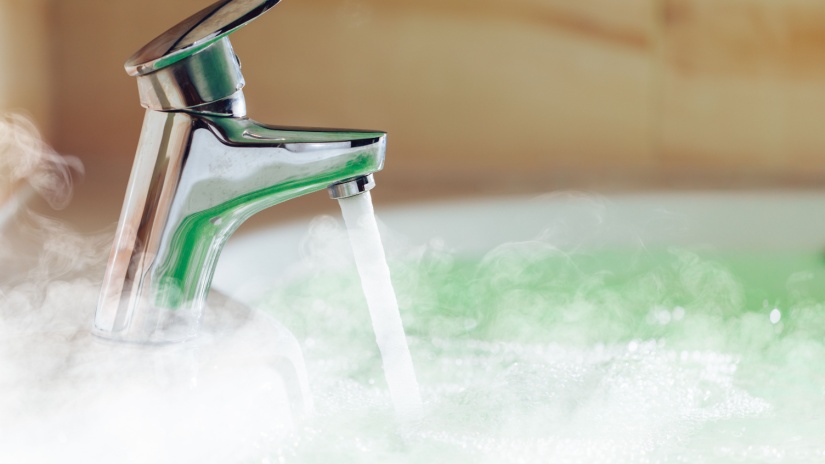Knowledge Centre
Everything you need to know about gas hot water systems

Heating water is one of the biggest energy uses in homes, accounting for 15% to 30% of total consumption. It’s also a major contributor to greenhouse gas emissions, responsible for up to 25% of emissions in a typical Australian household.
Using renewable energy sources can significantly cut down or even eliminate these emissions. This Compare Energy guide covers gas-powered and instantaneous hot water systems, detailing how they operate, their costs, energy efficiency, and pricing.
What is a gas hot water system?
A gas hot water system heats water for household use by using either natural gas or LPG.
There are three primary types of gas hot water systems: storage systems, continuous flow (also known as instantaneous) systems, and solar hot water heaters that include instantaneous gas boosting.
Storage hot water systems
These systems heat water and keep it in an insulated tank, so it’s ready whenever you need it.
Hot water is taken from the top of the tank, and cold water enters from the bottom. When you use hot water, the burner kicks in to warm up the cold water to the right temperature.
Most storage systems have a Gas Energy Rating between 4 and 5.3 stars.
However, storage systems do lose some heat through the tank walls, meaning they use energy even when you’re not using hot water. The larger the tank, the more heat (and energy) is lost.
For smaller households, this wasted energy can make up a significant portion of your hot water energy costs. In such cases, an instantaneous gas water heater might be more efficient and cost-effective.
If you’re away from home for a long time, turning off the gas pilot light can help save energy.
Instantaneous hot water systems
These systems heat water only when you need it, which means they use less gas than storage systems because there’s no heat lost through a storage tank.
Most instantaneous systems have a Gas Energy Rating between 5 and 6 stars, with the most efficient ones reaching a 7-star ‘equivalent’ rating.
However, these systems do use more gas overall compared to storage systems. If you’re switching from a storage system, you might need to install a new gas line to handle the increased gas usage.
Solar hot water heaters
Solar hot water systems harness energy from the sun to heat water, making them an eco-friendly and cost-effective option.
They typically consist of solar panels or collectors installed on the roof, which absorb sunlight and transfer the heat to water stored in a tank. These systems can significantly reduce electricity or gas bills and lower greenhouse gas emissions.
Many solar hot water systems include a backup, such as gas or electric, to ensure a continuous supply of hot water on cloudy days or during high demand. Although initial installation costs are higher, the long-term savings make them a worthwhile investment.
How do these systems work?
Storage gas hot water systems use a gas burner to heat water that is kept in a tank. These systems have a small flame, called a pilot light, which keeps the water at a set temperature all day, ready for use whenever needed.
Instantaneous, or continuous flow systems, heat water only when you turn on a tap. Unlike storage systems, they don’t use tanks. Instead, they use heat exchangers that warm the water as it passes through, right before it reaches the tap.
Solar hot water systems with gas boosters mainly use solar power to heat the water, with gas as a backup for cloudy or rainy days.
Benefits of gas hot water systems
There are plenty of benefits of installing gas hot water systems and some of those include:
- Fast heating: Gas systems heat water quickly, providing hot water almost instantly.
- Reliable supply: Unlike electric systems, gas systems are not affected by power outages, ensuring a steady hot water supply.
- Energy efficiency: Many gas hot water systems, especially continuous flow models, are energy-efficient, reducing overall energy consumption.
- Lower operating costs: Gas is often cheaper than electricity, leading to lower running costs over time.
- Environmentally friendly: Gas produces fewer greenhouse gas emissions compared to coal-powered electricity, especially when paired with solar systems.
- On-demand heating: Continuous flow systems only heat water when needed, avoiding the energy waste associated with keeping a tank of water hot all day.
- Compact design: Instantaneous gas systems are usually more compact, saving space as they don’t require large storage tanks.
- Longer lifespan: Gas hot water systems often have a longer lifespan compared to electric models, offering better long-term value.
If you think your home will benefit from a gas hot water system plan change, call our team at Compare Energy. You deserve to benefit from all of these advantages
Is it expensive to run a gas hot water system?
The cost of using a gas hot water system depends on factors like the size of your household, the type of system you have, and the gas prices in your area.
Sustainability Victoria notes that while instantaneous systems are more energy-efficient than storage systems, they tend to use more gas.
Is a gas hot water system right for you?
Choosing the best hot water system for your home depends on factors like household size, location, and existing energy connections. If you already have a mains gas connection, a gas hot water system could be a great fit.
Larger households may benefit from the fast recovery rates of these systems. However, if you don’t have a gas connection, you’ll need to weigh the extra cost of installation.
Knowing how much your gas provider is going to charge depends on your location and the type of plan available to you. Calling the team at Compare Energy on 1300 790 106 is a good start as we have all of the information you need on gas plans in your area.

